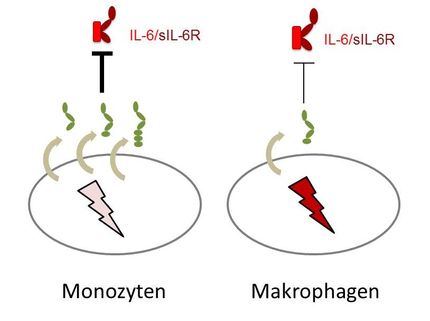Finding a potential new target for treating rheumatoid arthritis
Study reveals a novel pathway in autoimmune disease
By enhancing the activity of immune cells that protect against runaway inflammation, researchers at NYU Langone Medical Center may have found a novel therapy for rheumatoid arthritis and other autoimmune diseases. In a new study published in Science, the researchers reveal how treating these immune cells with an investigational drug wards off inflammation by holding a particular enzyme at bay.
"This is an unusual mechanism that could provide a potential therapeutic approach for the treatment of autoimmune diseases like rheumatoid arthritis or inflammatory diseases like Crohn's disease," says Michael Dustin, PhD, the Irene Diamond Professor of Immunology and professor of pathology at NYU Langone Medical Center.
The new study was spearheaded by Alexandra Zanin-Zhorov, PhD, a post-doctoral fellow in Dr. Dustin's lab, in collaboration with Juan Lafaille, PhD, associate professor of pathology and medicine, and Steven Abramson, MD, professor of medicine and pathology and director of the Division of Rheumatology. The research was supported in large part by a five-year grant from the National Institutes of Health Roadmap for Medical Research funding initiative, under its Nanomedicine Development Center Program.
Joint-destroying rheumatoid arthritis is generally considered an autoimmune disorder spurred on by the hyperactivity of conventional T cells that fight off infections, cancer, and other diseases. Within the past few years, researchers at NYU and other institutions have learned that other immune system components known as regulatory T cells counterbalance the tendency of conventional T cells to become overactive, thus holding inflammation in check.
These regulatory T cells exert their influence by communicating with other parts of the immune system. Through molecular detective work and powerful microscopy, the new study's collaborators found that an enzyme known as protein kinase C theta is only partly activated in regulatory T cells. When the regulatory cells are most active, in fact, most of the interfering enzyme is physically kept far away from the area important for cell-cell communication. "It's a very unique distribution," Dr. Dustin says. "In conventional T cells this enzyme is normally moved to the area where the cells are making contact. But in regulatory T cells, the enzyme is as far away as it can get from where the cells are communicating."
Based on that observation, the researchers began testing inhibitors of this kinase enzyme, including a molecule known as Compound 20 that had been in development by pharmaceutical company Boehringer Ingelheim. Surprisingly, the compound boosted the normal activity of regulatory T cells by about five-fold. The researchers found that specifically blocking the activity of the kinase enzyme augmented the natural tendency of the regulatory T cell to keep it out of the communication channels. Thus, the compound enhanced the regulatory cells' anti-inflammation activity.
The Yin and Yang of T cells in Rheumatoid Arthritis In rheumatoid arthritis, either an abnormal surge by infection-fighting T cells or a dip in the activity of inflammatory-fighting T cells — or perhaps both — could cause the immune system to attack our own joints instead. "Therefore, if you have an abnormal and suppressed regulatory T cell function, you have enhanced potential for autoimmunity," says Dr. Abramson.
The researchers bolstered previous evidence for such a link by examining the blood of 25 patients with varying degrees of rheumatoid arthritis. "In essence, what we were able to show is that if you look at this regulatory T cell population in rheumatoid arthritis patients, it is abnormally low in function, and the sicker the patients are, the more depressed that cell function is," says Dr. Abramson.
The defective regulatory cells from these patients were revived in tissue cultures with this enzyme inhibitor, the study showed. "We could get them back to almost a normal level of activity, like what you'd see in a healthy individual," says Dr. Dustin.
The researchers also tested the Compound 20 inhibitor in a mouse version of Crohn's disease, which is characterized by intestinal inflammation. When the researchers treated the regulatory T cells with the enzyme inhibitor and then injected them into the mice, their anti-inflammation activity rose so much that they essentially protected the mice from the disease, even though the cells were outnumbered four to one by their pro-inflammatory counterparts.
"The theory is that if you could restore normal regulatory T cell function, then you could restore their ability to suppress the inflammation process, and prevent this abnormal destruction of your joints," Dr. Abramson says.























































